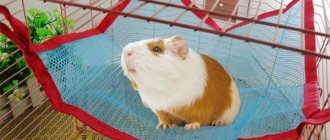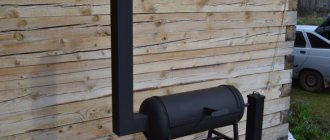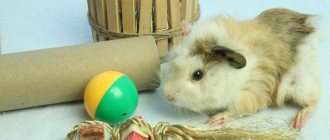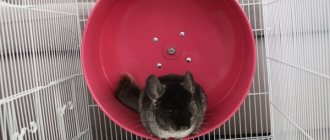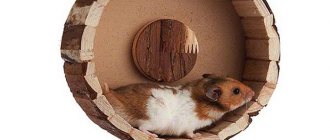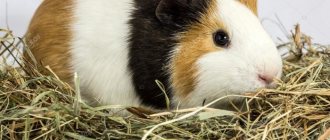There are a number of established exhibition rules that prohibit the display of animals in standard or strict collars and muzzles. As for the show ring, it can be adapted for a specific breed by purchasing it in a specialized store or at the exhibition itself.
However, it is not at all necessary to do this, because such an accessory is easy to make with your own hands. Existing diagrams and step-by-step instructions will allow you to make such an indispensable accessory yourself. Homemade solutions can be decorated with stones , fur, cords and other elements, which makes them especially elegant and original.
Purpose of a leash-noose
Each breed has a specific character. For some he is calm and balanced, for others he is mischievous and curious. If a puppy or adult dog shows curiosity or aggression towards other animals, it can be quite difficult to keep him on a leash, especially if he is large.
To stop a dog without making any effort, experts advise using a choke collar. This accessory will not allow the dog to suddenly run away, thanks to its special design. After walking on a leash for a short time, the dog will develop a reflex, and it will calmly begin to walk on a regular collar, without looping or tugging the owner in different directions.
Determining the length
First, you need to measure your tailed friend's neck. Determine the place on your neck where the collar will hang and take the size. Add 3-4 cm so that the dog feels comfortable in the collar. To calculate the required amount of paracord for our work, multiply the measured size by 4. The girth of the dog’s neck in this example is 45 cm. Hence, two skeins of paracord were needed, each 1.8 m long. (45×4=180).
Let's start weaving
Fold the cords in half and thread each through the single-slot end of the buckle. Now take the ring and pass both cords through it, move it close to the buckle. Next, thread each pair of loose paracord ends through its loop and pull tight.
Clamp the buckle
Clamp the buckle in a vice on a stable surface, this will make it much more convenient to weave the collar with your own hands, because... The buckle will stay in place and you will be able to keep the cords taut.
Making a knot
Take the left pair of cords and make a loop around the right pair as shown in the photo. We take the right pair of cords and carry out similar actions. We received a full cycle of our node.
We continue to weave
We continue to weave the collar until we reach a point that is 5 cm from the end. Pull the loose ends into the second part of the buckle and leave a couple of centimeters between the slot in the buckle and the knot.
Hiding the ends
Take two ends of different colors, wrap them around the free area that we left in the previous step and pass them from above into the loop that was formed. All that remains is to properly hide the ends, trim off the excess and cauterize it.
A DIY collar is an excellent and inexpensive alternative to a store-bought one. We offer you several step-by-step lessons on how to create one from nylon sling, leather and woven cord.
conclusions
It is worth remembering that the beauty of this accessory is certainly important, but its purpose is to restrain the dog. Therefore, pay more attention to the strength of materials and the quality of stitching. After all, an animal with a sudden movement can damage them and escape from your hands. If you doubt that the ring you made yourself will not be able to withstand the impulse of your pet, then purchase a leash in the store.
Show rings for dogs must be made of durable material.
Own or homeless
Let's separate the flies from the cutlets and figure it out: what kind of dog are we catching and why? If one of your own runs away - one conversation. If you have to help old ladies like this, like in the introduction, it’s completely different. It would be more appropriate to remain silent about the stray dog, because why catch him? But life situations are simply fantastic. For example, a neighbor always remembered her dog. He ran away a couple of years ago. And imagine the situation: you ran into this neighbor in the store, and you are returning home together. And she is suddenly surprised to recognize her dog in a stray dog running past. The same one who ran away many years ago.
The dog is shy because it is homeless. And the neighbor asks for help with catching the animal. How are we going to catch it?
Methods for pet dogs:
- Team.
- Imitation of the owner leaving.
- Delicacy.
- Dog whistle.
Let's talk about each method more specifically.
Use for behavior correction and training
A dog training noose is an indispensable accessory for the owner. Because with its help you can achieve obedience in a short time. If used correctly, the collar will not harm the dog.
It is necessary to accustom oneself to such a collar from puppyhood, since an adult dog has already formed its character, and the dog can react to the noose aggressively or passively. In case of aggression, the dog is calmed down, distracted from the leash by loosening the tension. After the pet has completely calmed down, you can gradually begin studying. Over time, the pet will form a reflex, and it will stop pulling in different directions.
With a passive reaction, the dog lies down and does not pay attention to the owner’s commands. In this case, dog handlers recommend making a slight jerk and rewarding him at the slightest activity. After some time, the animal will understand that the noose will not harm it and will unquestioningly carry out its tasks.
Training a dog with a choke collar
This collar is intended for training purposes only. It is better to carry it out in a deserted place so that no one distracts the animal.
Actions during classes:
Experts recommend using a noose only during exercise, and putting your pet on an ordinary collar while walking. This is explained by:
Training conditions
You should start training a dog only if it is in normal physical condition (not sick, not depressed and does not refuse food). It is better to feed the dog a couple of hours before, and take it for a walk just before practicing the commands, so that it does all the necessary things and slightly wastes energy, which will prevent absent-minded attention.
You should choose a secluded area for training - at the beginning of training, you do not want unnecessary noise and the presence of strangers, which the dog can be distracted by. It is better if it is a fairly spacious area in the fresh air that is familiar to the dog, with an even surface.
At first, it is better to avoid noisy places. Photo: Kate Hart
When the dog begins to make progress in mastering the command, you should slightly add distractions - change the training location or invite spectators. However, if the dog is very distracted, it is too early to leave the secluded training area.
What you need for training
To teach the “near” command, you will need a collar, a leash, treats for reward, and your favorite toy will also come in handy.
Training should be done daily for 15 minutes. If the dog is tired or distracted, it is best to stop training and continue the next day.
Which delicacy to choose
Treats for reward during training should be in the form of small pieces, not crumble and not get your hands dirty. You can only choose the most suitable treat for your dog through experience. These can be pieces of chicken, sausages, vegetables, fruits, cheese, dry food, and store-bought treats.
Industrially made treats for dogs
Some dogs willingly work for pieces of biscuits. The treat needs to be chosen so that it is desirable for your dog. It is better to choose several types of treats and alternate them periodically so that the dog does not get bored with them.
When to use a special collar
It is not always possible to teach a dog commands using ordinary techniques and equipment. If the dog is a fairly large breed, disobedient, hyperactive or aggressive, then a special collar can help you: a choke collar, a strict collar or an electronic collar.
All this ammunition requires knowledge of its practical use and special care in use.
How to make a dog leash with your own hands
A leash-noose or half-noose can be made at home. This does not require skill or much time, and the materials can be purchased at any hardware store.
DIY noose leash
You can make a noose leash yourself at home. To do this, you need to prepare the following materials:
The principle of making a figure eight leash for dogs:
DIY half-choke collar
Often dog owners believe that a choke collar can cause pain to their pet and instead of this accessory they purchase a half-choke leash. It is less traumatic for the dog’s psyche and is also easy to do at home. For this you will need:
Wicker options
You can weave a dog collar from a number of available materials. For this you can use:
- Fabric scraps;
- Old belts;
- Clothesline or nylon rope.
In addition to the above, you will need to take care of the clasp. This can be a flexiblex or a noose-type mechanism or a semi-noose type mechanism. For a noose, 2 identical metal rings are required, for a semi noose, 3 rings and a chain.
Note!
Cake decorating: TOP-170 photos of the best ideas for decorating a cake at home + instructions for beginners with simple patterns
- How to make a house out of cardboard: 140 best photos of children's crafts with your own hands + step-by-step manufacturing instructions with simple diagrams
DIY rose lamp - step-by-step instructions for creating a lamp with your own hands + original design ideas with photo reviews
Detailed Specifications
Collars differ in the material they are made of. Before purchasing an accessory, it is important to familiarize yourself with the different types and choose the most suitable one. They are made from the following materials:
- Nylon is the most durable dog collar, glides well, does not cling to rings, and can be used in any weather. The collar has a drawback: if pulled sharply, it can cause pain to the animal and cut the owner's hand.
- Leather - beautiful and comfortable, suitable for short-haired breeds. Without proper care, the collar quickly loses its attractive appearance.
- Metal - when used, it can harm the coat, so it is intended for dogs with short hair.
Important! A dog leash with a lock, made of combined materials, is also used for training.
The collar can harm the animal
The simplest option
The easiest way to make a collar is from a belt, because the main components are already ready. However, a dog's sparse neck can rival a human's waist. All you need to do is cut the belt to the required size and make new holes. For ease of use, it is also advisable to leave clamps for the free end and make a patch for the ring, to which the leash will eventually cling.
If the edge of the belt cut is not neat, it is advisable to decorate it. This can be done by treating it with metal rivets or stitching it with leather. The easiest way is to cover it with colored tape and carefully touch it with a lighter. If the belt is made of not very high-quality leather substitute, it can be strengthened. To do this, you need to glue a thick fabric tape on the inside with waterproof (shoe) glue. This trick will not only extend the life of the collar, but also make it more comfortable to wear.
Leash for a dog: types, how to make with photo
A dog leash is a mandatory attribute of a pet’s equipment, which every animal owner should have, regardless of its breed and size of the dog. This is especially true when the rules for walking pets have become significantly more complicated due to the adoption of new restrictive legislation.
It is important to choose this accessory correctly so that it is comfortable for the pet and the owner and corresponds to the purposes for which it is used.
What parameters must it meet?
The main parameters of the leash are determined by the following characteristics of the fishing line:
Breaking load. The breaking load of the leader should always be lower than that of the main line.
Color. Most anglers use clear line to make leaders because it is the most versatile.
But there are those who pay special attention to the color of the fishing line. In such a case, there are the following recommendations:
- very clear water - blue line;
- fishing in the grass - green line;
- fishing on a sandy bottom - yellow line;
- fishing on a pebble bottom - brown line;
- fishing in snags - black line.
- Length. The length of the leash is a very important parameter, which depends on the type of equipment and the fish that is the intended prey.
Depending on the type of equipment, the length of the leash varies within the following limits:
for a fly fishing rod – 15-20 centimeters; for a plug fishing rod – 10-15 centimeters; for match and Bologna rigs - 25-30 centimeters.
Depending on the type of fish, the length of the leash is:
- For bleak. A leash 10-15 cm long is quite sufficient, since fishing is carried out in the middle or surface layers of water.
- For roach. Depending on the type of equipment, the length of the leash varies from 15 to 30 centimeters.
- For bream. Bream need a long leader. If you have to fish in the bottom layer, the leash should be 25-30 centimeters long. Bream are often caught using bait lying motionless on the bottom. In such cases, a small pellet is installed in front of the hook at a distance of 5-10 centimeters, performing the function of a feeder. Having taken the bait in its mouth, the bream does not feel resistance, while the float rises and lies on its side, giving the angler a signal of a bite.
Expert opinion
Knipovich Nikolai Mikhailovich
Zoologist, hydrobiologist. I am interested in fishing at a professional level.
Attention! Monofilament fishing lines can be soft or hard. Rigid fishing line is more suitable for making leashes because it tangles less
Separately, it is worth mentioning leashes for catching predatory fish using float rigs. To catch perch with fry, fluorocarbon leashes with a single hook are used. To catch pike with live bait, use metal leashes made of soft leash material or thick fluorocarbon leashes. Hooks can be single, double or triple, depending on the fishing conditions.
Hooks for leashes should also be given close attention. Depending on the type of bait, hooks can be of different sizes, made of wire of different thicknesses, have a short or long shank, etc.
You can also find hooks of a specific shape, for example, carp hooks and red hooks. Hooks are produced with notches on the shank, designed to prevent the worm from slipping off the hook when casting and during fishing.
Taking measurements from your pet
To determine the length of the sling, taking into account all the necessary fastenings, first of all, we need to measure the circumference of the pet’s neck. If you don't have a soft sewing meter at hand, you can use any ribbon and then measure it with a regular ruler. Or just use the old collar as a guide.
You have measured the circumference of your dog's neck. We multiply the resulting value by 1.7.
That is, if your dog has a neck girth of 30 cm, multiply this figure by 1.7. It turns out that you will need a sling 51cm long. This will be the length of the main large outline.
For a small control circuit, the line should be slightly shorter. This length does not depend on what size your furry friend is. A sling length of 30-35cm will be sufficient.
The small contour only allows you to freely put the collar over your head, and then evenly distribute the load when the dog tightens and loosens the leash.
You don't have to worry that the collar will be too small or too big. To adjust the desired girth, we will later make an additional buckle on the main contour.
But you need to decide in advance on the width of the sling. The choice of sling width directly depends on the size, breed and age of your furry friend. If you have a large breed dog, then the sling should be wider and the fittings stronger.
For my Jack, I took fittings and a 2.5 cm wide sling. By the way, the size of all accessories is selected based on the width of the sling, and is measured by the width of the holes into which the sling will be threaded.
Sew a martingale collar
First of all, we sew the colored grosgrain ribbon onto the nylon sling. You can sew colored ribbon onto both the large and small outline. Or only on a large leash outline. Or you may not do it at all.
Let's start with the small outline. Take a short nylon sling. We put two oval metal rings on it and simply leave them in a free position. We don't need them yet.
We connect the ends of the small outline and stack them on top of each other. The overlap will be approximately 5cm.
We take a metal half-ring and insert it between the two ends of the sling into the resulting overlap.
To fix the half ring, sew both ends to the main sling as shown by the dotted lines.
To ensure that the seam is strong and reliable, we lay several rows of stitching. The small outline is completely ready.
We take the second one - a long piece of nylon sling. We thread one end of the sling into a metal oval ring attached to a small outline. We bend the end of the sling by about 4-5cm.
Sew the folded end to the main outline. For reliability, we also lay several rows of stitching.
You can simply lay several lines in one row. Then there is no need to bend the edge of the sling by 4-5 cm. It is enough to bend it 2-3cm. I always stitch in a crosswise direction. This line seems much more reliable to me.
Let's start fixing the second end of the long outline of the martingale collar. We take the free edge of the large outline and thread a double-slit buckle through it. How far you will thread it doesn’t matter at all.
Next, we thread the same free edge of the sling through the second metal oval half-ring located on the small contour. We pass it in the direction of the inside of the collar.
Well, then we thread the free edge again through the double-slot buckle. To make this easier, slightly loosen the first layer of the sling. We get a kind of loop through which we again thread the free edge.
Sew the free edge to the main outline of the collar.
Well, that's all, the collar is completely ready!
We hope our master class on making a martingale collar with your own hands was useful. You and your furry friend will appreciate all the benefits of this accessory.
Existing types of dog leashes
Today, modern industry offers a wide selection of this essential attribute of dog equipment. Each owner can choose the accessory that suits his pet.
Roulette leash for dogs
Widely popular among pet owners, it is often called an automatic or retractable tape leash.
Roulettes are especially convenient for walking pets inside city streets and parks, as they allow you to quickly adjust the length of the retractable part, shorten or lengthen it in one movement.
They can be cable or tape. The cable is much cheaper, but is only suitable for small pets. In addition, in this case it is dangerous to touch the retractable part with bare hands; you can cut yourself.
If the retractable part is in the form of a tape, it is absolutely safe and reliable. Its length can be from three to ten meters.
The tape measure has a mechanism that allows you to fix the set length, so the tape cannot get tangled in your legs and paws and does not get dirty, since it does not touch the ground.
The dog moves freely, runs or walks next to the person. The length shortens or lengthens automatically; it does not need to be constantly monitored.
Returning from walking the pet and unfastening the leash from the collar, the owner simply presses a button and winds the tape or cable into the box, so it does not take up much space when stored.
The disadvantages of roulette leashes include their relative high cost, the inability to use for walking hyperactive pets, and the dog’s rapidly developing habit of constantly pulling on the tape.
It is important not to allow your pet to chew on the tape - it is not very strong and wears out quickly if it bends often. In addition, the locking mechanism sometimes jams, especially with frequent jerking and tugging, debris and dirt.
Show leash
This is an exclusively exhibition accessory intended for show class dogs. Usually it is expensive and beautiful, but at the same time it is not striking and does not distract the attention of the public and judges from the dog’s exterior.
Show rings can be very different in design, but usually consist of a carabiner and two loops, one of which is put on the dog athlete’s neck, and the other on the owner’s wrist.
This is a very convenient and beautiful accessory.
Leash controller for dogs
This type of leash is designed to correct the dog's behavior. In fact, it acts as a noose; thanks to its use, the pet will quickly wean itself from pulling and tugging on the harness, rushing towards other animals and picking up pieces of food.
With the help of a leash-controller, the dog quickly learns many commands, such as “near”, “sit”, “lie down”, “no”. At the same time, this accessory can be used as classic ammunition.
Typically, the clamp on the controller is made of rawhide with a high resistance force, which allows the cord to hold the load and not fray. The tape itself is made of high-strength and wear-resistant material with a maximum tensile strength of up to 900 kg. In addition, it does not stretch when stretched.
There is also a screw carabiner that allows you to attach the cord to a regular collar; the second end can be fixed to the owner’s waist belt. In this case, his hands remain free.
There are also leash-controller models with one lock. Thus, this is a very convenient accessory that allows you to use it as a classic leash and controller for correcting your pet’s behavioral reactions, such as aggression, disobedience and others. In this case, the animal does not experience pain or psychological pressure, and does not receive any harm.
Dog leash
The dog wears a noose without a collar; its role is played by a special loop. If the dog begins to twitch and pull, it immediately tightens, preventing the pet from breaking the rules.
General recommendations
The regulations of modern exhibitions prohibit the display of dogs without a special noose. Any harnesses, muzzles, strict or casual collars are unacceptable. The further assessment of the pet and its victory in the ring depends on the correct choice of the ring. However, simply buying an accessory is not enough. The handler needs to know how to use it.
Currently, the list of exhibition rings is very extensive . On sale you can find products from the most manufacturers with different appearance and equipment.
- As already mentioned, ideally the noose should remain almost invisible and blend in with the color of the dog’s hair. In addition, the thinner the ring, the better it will be to control the pet. If you are the owner of a young and inexperienced dog, especially one of small breeds, it is better to start accustoming it to soft, wide rings with a flat or round cross-section.
- You can use a thin ring in cases where the dog will behave intelligently with different accessories.
- Give preference to those nooses whose color perfectly “disguises” the dog, complementing it, rather than indicating defects. Contrasting models divide the neck, violating the impression of integrity, so it is better to avoid them.
- In turn, black models are especially effective when displaying dark, gray or blue pets, and white models are especially effective when displaying light-colored and spotted dogs.
There are no special rules for choosing a ring shoe, but in order to avoid possible troubles, it is advisable to follow at least the basic recommendations. In this case, both your pet and you will be happy with the purchase.

